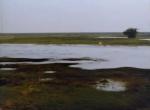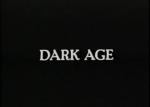AustLit
Latest Issues
AbstractHistoryArchive Description
One of only four films directed by Arch Nicholson before his early death from motor neurone disease, Dark Age follows the attempts by wildlife ranger Steve Harris, his girlfriend Cathy Pope, and trackers Oonadabund and Adjaral to capture a seven-metre salt-water crocodile (already responsible for two deaths) and relocate it to a breeding sanctuary. Their attempts are thwarted by hunter John Besser, determined on revenge after surviving an attack by the crocodile. In the course of the hunt, one of the trackers realises that he has a psychic connection to the crocodile.
According to Gary Couzens's online review for The Digital Fix,
'Dark Age is not a kill-the-monster story but a save-the-monster one. In fact, the real monster is a human - as played by Max Phipps, scary enough and just the right side of overplaying the part. The seven-metre croc may kill people (including a young child in a scene many will find upsetting) but it at least is obeying its nature. We do get moderately gory attack scenes (adroitly directed by Nicholson), a not always convincing but well disguised mechanical giant crocodile and a sex scene, but it's as if Nicholson and Borg are "smugglers" (in the Scorsese filmmaking sense), slipping in eco themes into what could have been a more straightforward exploitation horror movie. In addition, the two principal Aboriginals [sic] in the cast are treated with considerable dignity and sensitivity and, thanks to David Gulpilil's input, the Aboriginal rituals seen here are accurate. Also, the female lead has more to do than be decorative and to help demonstrate the hero's heterosexuality - maybe due to a female scriptwriter? - and the relationship between Steve and Cathy does ring true.'
Made as part of a two-picture deal with RKO Pictures (the other half of which was The Lighthorsemen), Dark Age was never released in Australia, thanks to negotiations with an Australian distributor falling through shortly after completion.
Source: The Digital Fix (http://film.thedigitalfix.com/content/id/75041/dark-age.html). (Sighted: 7/6/2012)
Notes
-
The trailer for this film (with a much more sensational font than was ultimately used for the titles) is available to view via YouTube: http://www.youtube.com/watch?v=5V9DXwMZVs4 (Sighted: 7/6/2012)
Publication Details of Only Known VersionEarliest 2 Known Versions of
Works about this Work
-
The 10 Scariest Animals in Australian Cinema - Sorted
2022
single work
column
— Appears in: The Guardian Australia , 24 October 2022; 'Want to spend this Halloween being scared by sharks in a supermarket or a giant kangaroo? Look no further than this list of films to watch from Luke Buckmaster.' -
Aussie Monster Movies : Six Terrifyingly Beastly Fright Fests
Erin Free
(editor),
2016
single work
column
— Appears in: FilmInk , 27 August 2016; -
Australian Eco-Horror and Gaia's Revenge : Animals, Eco-Nationalism and the 'New Nature'
2010
single work
criticism
— Appears in: Studies in Australasian Cinema , vol. 4 no. 1 2010; (p. 43-54)'We hear so much about extinction in debates around climate change. But what about those animals that go feral and then return – bigger, hungrier and angrier – to wreak revenge on humans who may have done them injustice? Using an eco-postcolonial framework, this article examines how a number of exploitation horror films have dealt with environmental topics and issues of trespass. In particular, I examine the agency of animals – crocs, pigs, thylacines and marsupial werewolves – in some key Australian eco-horror films from the last 30 years: Long Weekend (Eggleston, 1978), Razorback (Mulcahy, 1984), Dark Age (Nicholson, 1987), Howling III: the Marsupials (Mora, 1987), Rogue (Greg McLean, 2007), Black Water (Nerlich & Traucki, 2007) and Dying Breed (Dwyer 2008). On the one hand, these films extend postcolonial anxieties over settler Australian notions of belonging, while on the other, they signify a cultural shift. The animals portrayed have an uncanny knack of adapting and hybridizing in order to survive, and thus they (the films and the animals) force us to acknowledge more culturally plural forms of being. In particular, these films unwittingly emphasize what Tim Low has termed the ‘new Nature’: an emerging ethic that foregrounds the complex and dynamic interrelationships of animals with humans.'
Source: Publisher's blurb.
-
Aussie Monster Movies : Six Terrifyingly Beastly Fright Fests
Erin Free
(editor),
2016
single work
column
— Appears in: FilmInk , 27 August 2016; -
Australian Eco-Horror and Gaia's Revenge : Animals, Eco-Nationalism and the 'New Nature'
2010
single work
criticism
— Appears in: Studies in Australasian Cinema , vol. 4 no. 1 2010; (p. 43-54)'We hear so much about extinction in debates around climate change. But what about those animals that go feral and then return – bigger, hungrier and angrier – to wreak revenge on humans who may have done them injustice? Using an eco-postcolonial framework, this article examines how a number of exploitation horror films have dealt with environmental topics and issues of trespass. In particular, I examine the agency of animals – crocs, pigs, thylacines and marsupial werewolves – in some key Australian eco-horror films from the last 30 years: Long Weekend (Eggleston, 1978), Razorback (Mulcahy, 1984), Dark Age (Nicholson, 1987), Howling III: the Marsupials (Mora, 1987), Rogue (Greg McLean, 2007), Black Water (Nerlich & Traucki, 2007) and Dying Breed (Dwyer 2008). On the one hand, these films extend postcolonial anxieties over settler Australian notions of belonging, while on the other, they signify a cultural shift. The animals portrayed have an uncanny knack of adapting and hybridizing in order to survive, and thus they (the films and the animals) force us to acknowledge more culturally plural forms of being. In particular, these films unwittingly emphasize what Tim Low has termed the ‘new Nature’: an emerging ethic that foregrounds the complex and dynamic interrelationships of animals with humans.'
Source: Publisher's blurb.
-
The 10 Scariest Animals in Australian Cinema - Sorted
2022
single work
column
— Appears in: The Guardian Australia , 24 October 2022; 'Want to spend this Halloween being scared by sharks in a supermarket or a giant kangaroo? Look no further than this list of films to watch from Luke Buckmaster.'
- Arnhem Land, Top End, Northern Territory,





